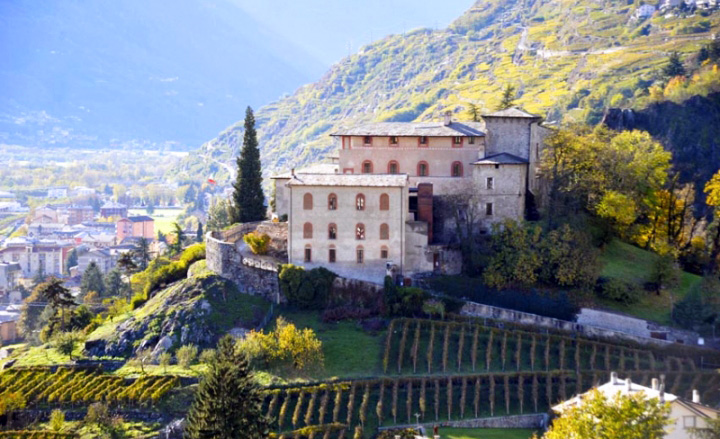The province of Sondrio is located in the northern Lombardy region and is a fascinating mix of different styles and eras, where man demonstrated his ingenuity by terracing the rugged lands that host its renowned vines. During the course of the last 400 years, four different countries have ruled the land, five if you want to count a rather short-lived autonomy for the area and six if you also want to include the Kingdom of Italy. To be honest, it is actually seven, since the province was established in 1815, within the Kingdom of Lombardy–Venetia!
The Romans included this area in their Cisalpine Gaul province. After the fall of the Western Roman Empire, it was settled by the Lombards and was first ruled by feudal lords from the local area. It fell under the rule of the Duchy of Milan (the House of Visconti and House of Sforza). Sondrio and Valtellina were strategically important in the geopolitical sphere of Europe, especially during the religious wars of the 16th and 17th centuries. This was due to Sondrio’s Spluga Pass that led into Switzerland. When the Duchy of Milan collapsed, rule over Sondrio was exercised by the Swiss Canton of Graubünden. The area was invaded by troops under the Spanish Governor of Milan in 1622, which held the territory until 1648, when peace was again secured and the area was again governed by the Swiss.
In 1797, the Republic of Valtellina was formed, but it was quickly conquered by the French. The Congress of Vienna in 1815 ceded Sondrio and Valtellina to Austria as part of the Kingdom of Lombardy–Venetia. It was absorbed into the Kingdom of Italy in 1866.
The province of Sondrio is mostly mountainous and sparsely populated. It shares the border with the Swiss canton of Graubünden to the north and has portions that border six other provinces in Lombardy – Como and Lecco to the west, Bergamo to the south and Brescia, Trento and Bolzano to the east. The province contains the highest mountains in Lombardy, the Rhaetian Alps. The valleys primarily run from north to south, the main ones being the Valtellina and Valchiavenna. One of the main towns is Livigno (almost 6,000 feet above sea level), which is a tourist center in the summer and a ski resort in the winter. There are 78 towns and villages in the province. Sondrio, with a population of less than 22,000, is the largest town in the province and is its administrative center. The Stelvio National Park, the largest nature park in Italy, is located in the north-eastern end of the province. The area is also known for the Passo dello Stelvio. With an elevation of 9,045 feet above sea level, it is the highest paved mountain pass in the Eastern Alps. Originally built between 1820 and 1825 to provide the Austrians access to the area, the road is an extraordinary series of switchbacks and hairpins, so challenging that Alfa Romeo selected the name for its exceptional SUV. The upper portion of the eastern ramp alone contains 48 hairpin turns. The nature trails along the route are dotted with WWI military ruins, remnants of the battles between Italy and Austria, where neutral Switzerland was so close that artillery shells flew over parts of its territory during battles between the two combatants.
Throughout the province, grapes have traditionally been grown, each district having its own local variety and producing its own local wine. For centuries, the valley’s northern slopes have been cleared of woods and rocks to terrace and cultivate these vines, which are a testament to man’s ability to transform nature and terrain, despite unfavorable conditions. It has been necessary for farmers to engineer terraces on the steep slopes, building dry stone retaining walls and moving earth to make the best use of terrain that is unsuitable for general agricultural purposes. These traditions of viticulture are embedded in the culture of the countryside.
Although most famous for wine and majestic alpine beauty, Sondrio also contains artistic treasures, such as the city center, which includes Piazza Garibaldi with elegant, neoclassical buildings and the Cinema Teatro Social, which dates back to 1820 and was designed by famed architect Luigi Canonica.
Narrow streets lead from the new to the old city center, which contain an array of styles from different eras – Renaissance, Baroque, neoclassical, modern and contemporary are each represented, while not far away is the medieval Castello Masegra. This imposing castle was built in the Middle Ages and was strategically positioned to control the entry into the Valmalenco Valley. Since it was the property of the influential Salis family, it is the only castle in the town of Sondrio which was not destroyed during the invasion of Valtellina in 1622. As time went by, the castle lost its original defensive function and was converted into an elegant residence more suited to a refined court, as was evidenced by frescoed rooms and beautiful loggias. It commands panoramic views over Sondrio and the valley. Numerous other castles and towers still stand in locations of formerly strategic importance, including de li Beli Miri Tower in Teglio; Castel Grumello, north of Sondia and Bellaguarda in Tovo di Sant’agata. Sanctuaries abound here, particularly the Blessed Virgin of Tirano, the Madonna della Sassarella standing on a promontory among the vines at the gates of Sondrio.
Of great economic importance to the area is the tourism associated with ski resorts. The valley was formed by glaciers and is very narrow at its lower section. The heart of the valley is the town of Chiesa in Valmalenco, also a major ski hub in the region. Collectively called “Skiarea Valtellina,” the district boasts nearly 250 miles of slopes for Alpine skiing and 125 miles of cross country trails. Italy created the all-inclusive ski report and these can be visited at the famous international resorts of Livigno, Bormio, Santa Caterina Valfurva, Aprica and at least a dozen more.
Valtellina is also a summer destination and in the warmer months shows off an explosion of color in its numerous nature parks and reserves, that include Stelvio National Park; the park in Orobie Valtellinesi, which contains a wildlife observatory at Aprica and the Nature Reserve of Val di Mello.
Finally, the province also boasts thermal spas dating from ancient Roman times; the therapeutic waters in these terme can be enjoyed while admiring the splendid scenery of the surrounding mountains. These spas include the Bormio Spa, Bagni Vecchi, the Bagni of Masino and the finest of all, the Grand Hotel Bagni Nuovi in Valdidentro. Although it is one of the most sparsely populated areas in Italy, the province is filled with the wonders of man and nature.





